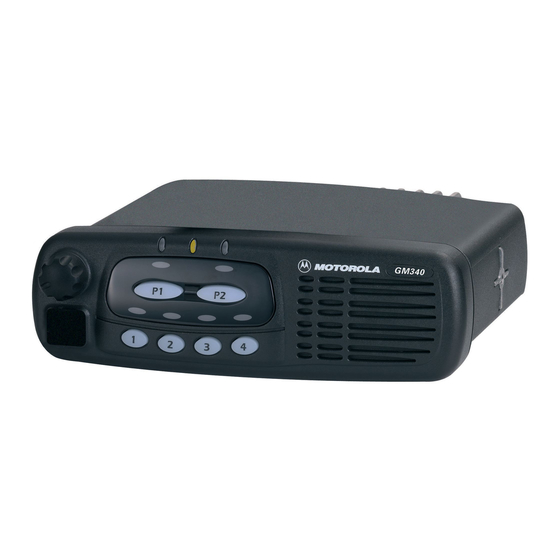Motorola GM340 Сервісна інформація - Сторінка 12
Переглянути онлайн або завантажити pdf Сервісна інформація для Радіо Motorola GM340. Motorola GM340 32 сторінки. Gm series professional radio uhf (403-470mhz)
Також для Motorola GM340: Посібник користувача (32 сторінок), Сервісна інформація (34 сторінок), Сервісна інформація (32 сторінок)

2-2
There are two 2-pole 44.85 MHz crystal filters in the high-IF section and 2 pairs of 455 kHz ceramic
filters in the low-IF section to provide the required adjacent channel selectivity .The correct pair of
ceramic filters for 12.5 or 25KHz channel spacing is selected via control line BWSELECT. The
second IF at 455 kHz is mixed, amplified and demodulated in the IF IC. The processing of the
demodulated audio signal is performed by an audio processing IC located in the controller section.
2.2
Front-End Band-Pass Filters & Pre-Amplifier
The received signal from the radio's antenna connector is first routed through the harmonic filter and
antenna switch, which are part of the RF power amplifier circuitry, before being applied to the
receiver pre-selector filter (C4001, C4002, D4001 and associated components). The 2-pole pre-
selector filter tuned by the varactor diodes D4001 and D4002 pre-selects the incoming signal
(RXIN) from the antenna switch to reduce spurious effects to following stages. The tuning voltage
(FECTRL_1) ranging from 2 volts to 8 volts is controlled by pin 20 of PCIC (U4501) in the
Transmitter section. A dual hot carrier diode (D4003) limits any inband signal to 0 dBm to prevent
damage to the pre-amplifier.
The RF pre-amplifier is an SMD device (Q4003) with collector base feedback to stabilize gain,
impedance, and intermodulation. The collector current of approximately 11-16 mA is drawn from the
voltage 9V3 via L4003 and R4002. A switchable 3dB pad (R4066,R4007,R4063, R4064 and
R4070), controlled via line FECTRL_2 and Q4004 stabilizes the output impedance and
intermodulation performance.
A second 2-pole varactor tuned bandpass filter provides additional filtering of the amplified signal.
The varactor diodes D4004 and D4005 are controlled by the same signal FECTRL_1, which
controls the pre-selector filter. A following 1 dB pad (R4013 - R4015) stabilizes the output
impedance and intermodulation performance.
2.3
First Mixer and High Intermediate Frequency (IF)
The signal coming from the front-end is converted to the first IF (44.85 MHz) using a cross over
quad diode mixer (D4051). Its ports are matched for incoming RF signal conversion to the 44.85
MHz IF using low side injection via matching transformers T4051 and T4052. The injection signal
(RXINJ) coming from the RX VCO buffer (Q4332) is filtered by the lowpass filter consisting of
(L4053, L4054, C4053 - C4055) followed by a matching transformer T4052 and has a level of
approximately 15dBm.
The mixer IF output signal (IF) from transformer T4501pin 2 is fed to the first two pole crystal filter
FL3101. The filter output in turn is matched to the following IF amplifier.
The IF amplifier Q3101 is actively biased by a collector base feedback (R3101, R3106) to a current
drain of approximately 5 mA drawn from the voltage 5V. Its output impedance is matched to the
second two pole crystal filter FL3102. The signal is further amplified by a preamplifier (Q3102)
before going into pin 1 of IFIC (U3101).
A dual hot carrier diode (D3101) limits the filter output voltage swing to reduce overdrive effects at
RF input levels above -27 dBm.
2.4
Low Intermediate Frequency (IF) and Receiver Back End
The 44.85 high IF signal from the second IF amplifier feeds the IF IC (U3101) at pin1. Within the IF
IC the 44.85 MHz high IF signal mixes with the 44.395 MHz second local oscillator (2nd LO) to
THEORY OF OPERATION
